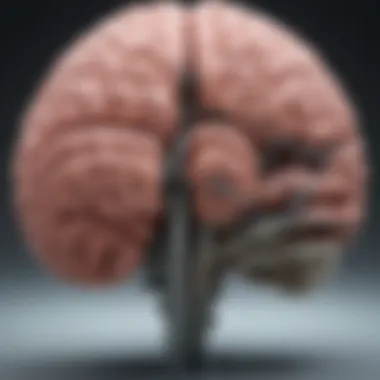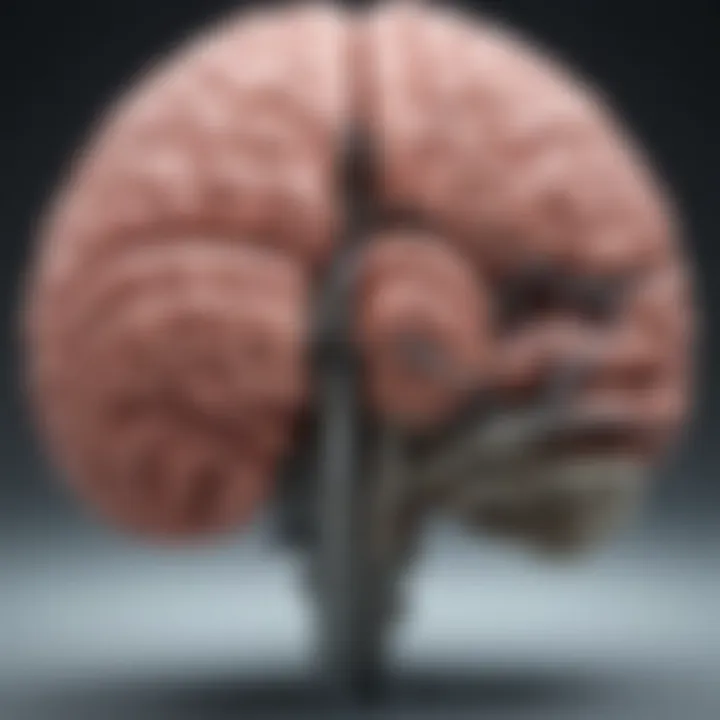Exploring the Cognitive Brain: Functions and Structures


Intro
The cognitive brain is a complex and intricate network that governs how we think, learn, and interact with the world around us. Understanding its structures and functions is essential for various fields, including education, mental health, and even artificial intelligence. This exploration aims to enlighten readers on the latest research findings and theories that shape our understanding of cognitive processes.
With a focus on neuroplasticity, this discussion unearths how our brains adapt over time, demonstrating remarkable flexibility. The implications are profound—pertaining not just to individuals but to educational systems and therapeutic practices as well. In this article, we will distinguish key components of the cognitive brain, examine current research, and discuss potential applications in multiple domains.
Research Overview
Key Findings
- Neuroplasticity enables the brain to reorganize itself by forming new neural connections throughout life.
- Cognitive functions such as attention, memory, and problem-solving are localized but work collaboratively across various brain regions.
- Recent studies reveal how environmental factors and experiences significantly shape cognitive development.
Study Methodology
Research on cognitive functions often employs a combination of techniques, including:
- Neuroimaging such as fMRI and PET scans to visualize brain activity.
- Behavioral assessments to evaluate cognitive capabilities in real-world scenarios.
- Longitudinal studies that track cognitive development over time in different populations.
Background and Context
Historical Background
The study of the cognitive brain has evolved significantly since the early days of psychology. Early theories largely focused on behavioral aspects, neglecting the underlying neurological processes. Over decades, advances in technology and neuroscience have shifted this perspective, allowing for a more integrated view of cognition and brain functions.
Current Trends in the Field
Today, more researchers are exploring the connections between cognitive neuroscience and practical applications in education and mental health. Areas such as cognitive rehabilitation and the integration of AI in learning environments are particularly active. As research continues to reveal the brain's complexities, a need for interdisciplinary collaboration becomes increasingly important.
Understanding the cognitive brain is not merely academic; it impacts educational methodologies, mental health interventions, and even the development of intelligent systems.
Through this article, we aim to provide a comprehensive overview, thereby enriching knowledge on how the cognitive brain operates and its implications in diverse contexts.
Intro to the Cognitive Brain
The cognitive brain plays a fundamental role in how humans think, learn, and interact with the world. It encompasses various functions and processes that shape our perception and decision-making capabilities. Understanding the cognitive brain is not just an academic exercise; it has real-world implications for education, mental health, and artificial intelligence. Through this article, we will delve into the intricate structures and significant functions of the cognitive brain, thereby illuminating its relevance in everyday contexts.
By exploring the cognitive brain, one appreciates how thoughts and behaviors emerge from neural activity. This understanding is beneficial for students, educators, and professionals, providing insights that can enhance teaching methodologies and promote better cognitive strategies. Additionally, recognizing the brain's plasticity allows for more effective therapeutic approaches in cognitive rehabilitation, addressing various mental health concerns.
In summary, this section lays the groundwork for a comprehensive examination of the cognitive brain, emphasizing its function and significance in both research and practical applications.
Defining the Cognitive Brain
The term "cognitive brain" refers to the complex neural structures and networks that underpin cognition, which includes processes such as thinking, memory, and decision-making. It primarily involves several brain regions working cohesively to facilitate these functions. Key areas include the cerebral cortex, which is divided into lobes, and structures such as the limbic system. Each region contributes uniquely to different cognitive tasks.
Cognition itself can be defined as the mental action of acquiring knowledge and understanding through thought, experience, and the senses. While many may associate cognition with high-level reasoning, it also encompasses simpler processes like perception and attention. The cognitive brain operates through networks that connect various regions, allowing for integrated functioning and complex behaviors.
Historical Context of Cognitive Neuroscience
Cognitive neuroscience emerged as a field of study in the late 20th century, blending principles from psychology and neuroscience. The evolution of this discipline has been marked by significant advancements in technology, such as neuroimaging techniques like MRI and PET scans. These tools allow researchers to observe the brain in action, enhancing our understanding of its role in cognition.
Historically, thinkers like Plato and Descartes laid foundational ideas about the connection between the mind and the body. However, it was not until the advent of modern psychology and biology that researchers began to investigate more systematically how the brain relates to cognitive processes. The integration of these disciplines serves as a parenthesis in understanding how physical brain structures influence mental functions.
"Cognitive neuroscience bridges the gap between cognitive psychology and neurobiology, creating a comprehensive view of how we think and process information."
Over the decades, cognitive neuroscience has grown to illuminate various mental functions, leading to practical applications in areas such as education and mental health. By connecting the dots between cognitive processes and brain structures, its trajectory continues to impact various fields significantly.
Anatomy of the Cognitive Brain
Understanding the anatomy of the cognitive brain is essential for grasping how various structures contribute to cognitive functions. Each area of the brain plays a distinct role in processing information, regulating emotions, and executing complex tasks. Recognizing these elements helps researchers and practitioners to appreciate the intricate workings of the mind and how they relate to behavior and cognition. This section highlights the major lobes of the brain, the limbic system, and brain connectivity, all of which are fundamental in the study of cognitive neuroscience.
Major Lobes and Their Functions
Frontal Lobe


The frontal lobe is often regarded as the seat of higher-order processing in the brain. It is crucial for functions such as decision-making, problem-solving, and regulating behavior. An important characteristic of the frontal lobe is its involvement in the planning and execution of movements, reflecting its role in motor control.
The frontal lobe is a beneficial area to explore in this article due to its central role in executive functions. Its unique feature is the prefrontal cortex, responsible for complex cognitive behavior and personality expression. Understanding its advantages and disadvantages can significantly inform approaches in cognitive therapy and education, as impairments in this area can lead to difficulty in judgment and social interactions.
Parietal Lobe
Next, the parietal lobe serves as the primary sensory integration center. It processes tactile information and is essential for spatial awareness and navigation. This lobe's key characteristic is its ability to combine sensory input from various modalities, allowing for a cohesive perception of the environment.
In the context of this article, the parietal lobe is pivotal for its contributions to spatial reasoning and attention mechanisms. A unique aspect of this lobe is its role in proprioception, or the body's sense of position. Issues in this area can lead to deficits in sensory integration, affecting daily functioning.
Temporal Lobe
The temporal lobe is primarily associated with auditory processing and memory formation. It is here that aspects of language comprehension and emotional responses emerge. Its significant characteristic is the hippocampus, known for its role in forming new memories and learning.
Focusing on the temporal lobe is advantageous in understanding cognition, particularly regarding memory and language. This lobe's unique feature emphasizes its dual role in processing sounds and forming memories, which can impact various cognitive disorders if damaged.
Occipital Lobe
Finally, the occipital lobe is the primary visual processing center of the brain. It is essential for interpreting visual stimuli, making sense of shapes, colors, and motion. A key feature of the occipital lobe is its complex mapping of visual fields, which allows for detailed visual perception.
Including the occipital lobe in this discussion is important as it underscores how visual information is processed and affects cognitive functions like attention and memory. However, damage to this area can lead to significant visual impairments and hallucinations, illustrating the delicate balance within cognitive processing.
The Limbic System's Role in Cognition
The limbic system plays a critical role in emotion, memory, and arousal. This collection of structures, including the hippocampus and amygdala, is vital for forming memories and managing emotional responses. The capacity for emotional regulation directly impacts cognitive processes, making the limbic system central in cognitive neuroscience. The connections between emotional states and cognitive functions highlight the complexity of human behavior and thought.
Brain Connectivity: Networks and Pathways
Brain connectivity refers to how different regions of the brain communicate and work together. Networks such as the default mode network, executive control network, and salience network are crucial in understanding higher-order cognitive processes. These networks facilitate cooperation between various brain areas, enhancing cognitive flexibility and efficiency. Studying these connections provides insight into disorders like ADHD, schizophrenia, and Alzheimer’s disease, revealing how disrupted connectivity can lead to cognitive impairments.
Key Insight: The intricate connections between brain regions not only support cognitive function but also inform therapeutic approaches in mental health and rehabilitation.
Cognitive Functions and Processes
Cognitive functions and processes are central to our understanding of how the brain operates. This section delves into the mechanisms that underlie various cognitive capabilities, including memory, attention, language processing, and decision-making. These processes are fundamental in shaping our experiences and interactions with the environment. Grasping these functions helps in many fields, from education to artificial intelligence. Each cognitive process plays a distinct role in our daily lives and influences everything from learning strategies to problem-solving techniques.
Memory: Types and Mechanisms
Memory is a core component of cognitive functions. It allows individuals to encode, store, and recall information, thus playing a critical role in learning and adaptation.
Short-term Memory
Short-term memory represents the immediate retention of information. This system allows individuals to hold a limited amount of information for a brief period. One key characteristic of short-term memory is its capacity, which typically holds seven items plus or minus two. This limit illustrates why people often utilize mnemonic devices to aid recollection.
Short-term memory is beneficial in situations requiring quick recall or immediate decision-making, such as remembering a phone number long enough to dial it. However, its primary disadvantage lies in the ephemeral nature of the information retained, making it vulnerable to loss unless transferred to long-term memory through rehearsal or encoding strategies.
Long-term Memory
Long-term memory is crucial for storing vast quantities of information over extended periods, ranging from days to a lifetime. One notable characteristic of long-term memory is its seemingly limitless capacity. This function enables individuals to preserve knowledge about facts, experiences, and skills. Long-term memory is particularly useful for academic achievement and personal development.
Its unique feature is the potential to recall past experiences and learned information, which enriches an individual’s understanding of the world. However, long-term memory can also be subject to distortions and inaccuracies, which means not all recalled information may perfectly represent the initial experience.
Working Memory
Working memory refers to a cognitive system responsible for holding and manipulating information temporarily. This type of memory is vital for tasks requiring active engagement, such as problem-solving and reasoning. A defining characteristic of working memory is its dynamic nature; it allows individuals to process and integrate information in real time.
Working memory is essential for maintaining focus and sequencing tasks effectively, which is advantageous in both academic and professional environments. However, it can be easily overwhelmed if too much information is introduced at once, leading to cognitive overload and errors in judgement.
Attention and Focus
Attention and focus regulate cognitive resources, enabling individuals to concentrate on particular tasks while ignoring distractions. This ability influences learning outcomes and productivity levels. Factors such as motivation and environmental context significantly impact attention. Understanding how attention works can enhance strategies for improving focus in educational settings and beyond.
Language Processing in the Brain


Language processing encompasses the brain's ability to comprehend and produce language. This complex function involves several regions, primarily in the left hemisphere, including Broca’s area and Wernicke’s area. Effective language processing is vital for communication and social interaction. The insights gained from studying how the brain processes language inform approaches in education, speech therapy, and AI.
Decision Making and Problem Solving
Decision making and problem solving are interdependent cognitive functions that greatly influence personal and professional experiences. These processes encompass evaluating options, forecasting outcomes, and making choices. Understanding the neural basis of these activities allows for improved cognitive strategies and methods to enhance critical thinking. Cognitive biases and emotional factors often affect decision-making processes, highlighting the importance of awareness in effective problem-solving.
Cognitive Development Across the Lifespan
Cognitive development throughout a person's life is critical in understanding how the brain evolves and adapts over time. This evolution shapes our abilities, behaviors, and understanding of the world around us. By studying cognitive development, one gains insight into how individuals learn, think, and interact at different stages of life. Each phase from infancy to adulthood brings distinct cognitive capabilities and challenges. Understanding these changes is essential for educators, health professionals, and researchers. Their desire for effective strategies to facilitate learning and cognitive health across different age groups cannot be overstated.
From Infancy to Adolescence
The cognitive development journey begins at birth. Infants exhibit reflexive responses and gradually move towards more complex cognitive abilities. This early stage involves sensory experiences and simple actions. Babies learn through interactions with their caregivers. By crying, they discover how their needs can be met.
In later childhood, the development of language occurs. Children begin to communicate verbally, enhancing their social interactions. The ability to think logically develops further in school-age children. They progress from concrete operational thought to more abstract reasoning in adolescence. From around ages 12 to 18, adolescents start refining skills such as critical thinking and problem-solving. These skills are crucial for future academic and social endeavors. Additionally, according to Piaget's theory, adolescents experience a significant cognitive leap towards formal operational thinking, which involves strategizing and planning.
"Cognitive development during childhood provides the foundation for lifelong learning and skill acquisition."
This phrase highlights the necessity of recognizing milestones in cognitive development during this time. Understanding these milestones can help foster an environment conducive to learning and growth.
Cognitive Aging in Adulthood
As individuals transition into adulthood, cognitive abilities continue to evolve, albeit in different ways. Early adulthood is often characterized by peak cognitive performance. Critical thinking, problem-solving, and creative skills reach their highest potential. However, as one progresses into middle and later adulthood, a decline in certain cognitive functions may become evident.
Research indicates that while some cognitive functions like processing speed may decline, others, such as vocabulary and knowledge, often remain stable or even improve. It is important to note that cognitive aging does not equate to cognitive decline.
Strategies to maintain and enhance cognitive functions become vital at this stage. Engaging in lifelong learning, physical activity, and social interactions contributes to cognitive health. Mental exercises such as puzzles and reading are beneficial. Maintaining a healthy lifestyle involving diet and sleep also promotes cognitive well-being. Understanding these dynamics can significantly assist in creating effective interventions to support cognitive health in older adults.
Neuroplasticity and Cognitive Rehabilitation
Neuroplasticity is an essential topic in understanding how the brain adapts to changes in the environment or following injury. This concept emphasizes that the brain is not a static organ; instead, it has the remarkable ability to reorganize itself by forming new neural connections. This adaptability is particularly vital for cognitive rehabilitation. Rehabilitation often focuses on helping individuals regain lost functions, whether due to stroke, traumatic brain injury, or other neurological conditions. Understanding neuroplasticity is crucial because it underpins the therapeutic processes that can lead to recovery and improved cognitive skills.
The benefits of neuroplasticity are significant. For example, when the brain compensates for lost function, it often involves the recruitment of different brain areas to take on roles that were previously managed by the damaged parts. Rehabilitation strategies leverage this inherent capacity for change. Clinicians often design therapies that promote engagement, repetition, and skill-building, which stimulate neuroplastic processes.
However, there are considerations that need to be addressed. The effectiveness of neuroplasticity can vary based on numerous factors, such as the individual's age, the severity of the injury, and the timing of intervention. Critical time windows exist where the brain's capacity for recovery is enhanced. Therefore, early intervention can greatly influence the outcome of cognitive rehabilitation.
"The brain's ability to change throughout life is not only fundamental to recovery but also to learning and memory formation."
The Concept of Neuroplasticity
Neuroplasticity can be classified into two main types: functional plasticity and structural plasticity. Functional plasticity refers to the brain's ability to shift functions from damaged areas to undamaged areas. In contrast, structural plasticity changes the actual physical structure of the brain in response to new learning activities or experiences. This category encompasses the growth of new neurons and the strengthening or weakening of synapses.
Research has shown that neuroplastic changes can occur through various experiences, such as learning a new skill, practicing a musical instrument, or even engaging in physical exercise. The brain's neuroplastic capabilities are increasingly recognized in both educational settings and clinical practices, driving innovative ways to facilitate learning and rehabilitation.
Therapeutic Approaches to Enhance Cognition
Several therapeutic approaches have been developed to harness neuroplasticity for cognitive enhancement. These approaches can be grouped into a few categories:
- Cognitive Training Exercises: These activities involve tasks that strengthen specific cognitive functions like memory or attention. Programs like Lumosity use games that aim to improve cognitive skills through engagement and practice.
- Physical Rehabilitation Therapy: Therapies that combine physical exercises with cognitive tasks have shown promise. For instance, tasks that require coordination can enhance brain connectivity and improve cognitive outcomes.
- Mindfulness and Meditation: Practices like mindfulness and meditation have been associated with structural changes in the brain. They promote emotional regulation and may enhance attention and working memory.
- Transcranial Magnetic Stimulation (TMS): This non-invasive procedure stimulates small regions of the brain using magnetic fields. TMS has been explored as a method for improving cognitive functions in various conditions, including depression and stroke recovery.
Implications of Cognitive Brain Research
The research on the cognitive brain offers a wide range of implications that extend beyond basic understanding of neurological functions. It is pivotal in various fields, influencing practices, methods, and innovations that directly impact society. Understanding cognitive processes aids in developing effective strategies in education, advances in artificial intelligence, and improving mental health treatments. Each of these areas reflects the integration of cognitive neuroscience findings into real-world applications, emphasizing the importance of continued study in this domain.
Education: Teaching Strategies Informed by Cognitive Science
Cognitive brain research plays a significant role in shaping educational practices. By understanding how students learn, educators can develop teaching strategies that align with cognitive processes. Research shows that knowledge retention and comprehension improve when instruction is tailored to how the brain processes information.
Some effective teaching strategies informed by cognitive science include:
- Active Learning: Encourages students to engage with the material actively, promoting deeper understanding.
- Spaced Repetition: Utilizes the brain’s natural forgetting curve, enhancing long-term memory retention.
- Multimodal Instruction: Combines various teaching methods to cater to different learning styles and enhance information accessibility.
"By applying cognitive science principles, educators can create environments that foster optimal learning outcomes."


Implementing these strategies can lead to enhanced academic performance and motivation among students, ultimately leading to success in their educational journeys.
Artificial Intelligence and Cognitive Modeling
Cognitive neuroscience directly influences developments in artificial intelligence (AI). The exploration of human cognition informs the design of algorithms and models that mimic brain processes. This interchange fosters the creation of intelligent systems capable of learning, reasoning, and decision making similar to humans.
Key areas where cognitive modeling is applied include:
- Natural Language Processing: Enables machines to understand and respond to human language effectively.
- Machine Learning: Applies principles of cognition to improve learning from data over time.
- Neural Networks: Mimics the interconnections of neurons, allowing for complex problem-solving.
As researchers push the boundaries of AI, integrating findings from cognitive neuroscience will continue to optimize these technologies. The implications are vast, affecting various industries and enhancing interaction between humans and machines.
Mental Health: Insights from Cognitive Neuroscience
The relationship between cognitive neuroscience and mental health is profound. Insights gained from studying the cognitive brain inform treatment approaches for various psychological disorders. Recognizing how cognitive processes are altered in conditions like depression, anxiety, or PTSD leads to targeted interventions.
Cognitive behavioral therapy (CBT) is an example of treatment that incorporates cognitive science principles. It helps individuals understand and change their thought patterns, thereby improving emotional regulation. Other key insights include:
- Neurological Underpinnings: Understanding brain structures associated with emotional regulation and decision making.
- Cognitive Rehabilitation: Methods to recover lost cognitive functions after injury or illness.
- Preventative Strategies: Insights into maintaining mental health through cognitive exercises and practices.
By continuing to explore cognitive processes in relation to mental health, researchers can develop better therapeutic interventions that promote psychological well-being and ultimately improve quality of life.
Future Directions in Cognitive Neuroscience
The field of cognitive neuroscience is rapidly evolving. With advancements in technology and an increase in interdisciplinary collaboration, the future holds much promise for understanding the cognitive brain. This section examines emerging trends, technologies, and approaches that are shaping the landscape of cognitive science. These developments not only promise greater insights into brain functions but also have practical implications for education, mental health, and artificial intelligence.
Emerging Technologies in Brain Research
Emerging technologies are revolutionizing the study of cognitive neuroscience. Tools such as functional magnetic resonance imaging (fMRI) and transcranial magnetic stimulation (TMS) allow researchers to observe brain activity in real time. The following innovations are particularly noteworthy:
- Neuroimaging Techniques: Beyond fMRI, techniques like positron emission tomography (PET) and optical imaging provide different perspectives on brain activity and structure.
- Wearable Devices: The rise of wearable brain-computer interfaces offers real-time monitoring of neural activity, enabling a deeper understanding of brain states in naturalistic settings.
- Machine Learning: This technology is utilized to analyze complex neural data, enabling the identification of patterns that could predict cognitive outcomes.
These technologies enhance our capability to understand cognitive processes and how they differ among individuals. As these tools continue to mature, they may lead to more personalized approaches in fields such as education and mental health.
"Advancements in brain imaging fundamentally change how we perceive and study cognition."
Interdisciplinary Approaches to Understanding Cognition
Cognitive neuroscience benefits significantly from interdisciplinary collaboration. Insights from fields such as psychology, artificial intelligence, linguistics, and education contribute to a more comprehensive understanding of cognition. This synergy provides several advantages:
- Enhanced Research Outcomes: Blending methodologies from diverse fields fosters innovative research that may lead to breakthroughs, such as new learning strategies based on cognitive principles.
- Broader Applications: Insights from cognitive neuroscience inform not only academic circles but also practical applications in technology, healthcare, and education. For example, findings on cognitive load and attention can improve educational technology.
- Cultural and Social Context: Incorporating perspectives from sociology and anthropology allows for a deeper understanding of how cognition is shaped by cultural factors.
The future of cognitive neuroscience lies in this interdisciplinary approach. As boundaries between disciplines continue to blur, researchers are likely to uncover new paradigms that inform and enhance our understanding of cognitive functions.
Closure
The conclusion serves a critical role in synthesizing the insights gained from exploring the cognitive brain, encompassing its functions, structures, and broader implications. It encapsulates the main findings of the research and connects them to practical applications in various fields.
In this article, we have outlined how cognitive functions correlate with specific brain structures, emphasizing the intricate relationship melded among regions like the frontal and parietal lobes. Understanding these relationships not only enlightens us about the processes of memory, language, and decision making but also informs practices in education and mental health. Cognitive neuroscience has fostered advancements that aid in more effective teaching strategies and therapeutic approaches for cognitive rehabilitation.
Furthermore, neuroplasticity emerges as a prominent theme, underscoring the brain's capacity to adapt and reorganize itself in response to learning and recovery. This concept is pivotal when considering interventions designed to enhance cognitive abilities or support recovery from brain injuries.
Key Takeaway: A deeper understanding of the cognitive brain not only enhances our theoretical framework but also has real-world implications for education, artificial intelligence, and mental health interventions.
Overall, the conclusion highlights the need for continued exploration in cognitive neuroscience. As technology evolves, so too will our capacity to glean new insights into the functioning of the brain, leading to innovations that could transform our approach to learning and well-being.
Summary of Key Insights
- The cognitive brain encompasses various functions organized within distinct structural regions.
- Neuroplasticity illustrates the brain’s remarkable ability to adapt over time, supporting both learning and recovery from injuries.
- Cognitive neuroscience findings inform practical applications across diverse fields, enhancing educational methods and mental health interventions.
- Frontal lobe is central to decision making and problem-solving.
- The parietal lobe plays a vital role in processing sensory information, which informs cognitive functions.
- The limbic system is crucial in understanding emotions and memory.
The Importance of Continued Research
Continued research in cognitive neuroscience is imperative. As our understanding of the brain grows, we must explore the frontiers of how cognitive functions can be improved or restored. Emerging technologies such as functional MRI and advanced neuroimaging provide unprecedented insights into brain activity.
Moreover, interdisciplinary approaches foster collaboration among researchers, educators, and clinicians to translate findings into practical strategies. This collaboration can lead to improved educational frameworks that cater to different learning modalities and age groups, ensuring that all individuals gain the best cognitive outcomes.
Research may also unlock potential treatments for mental health disorders, offering pathways to innovative interventions grounded in neuroscience. Therefore, sustained investment in research is not merely a benefit but a necessity to harness the full potential of cognitive neuroscience for societal advancement.







